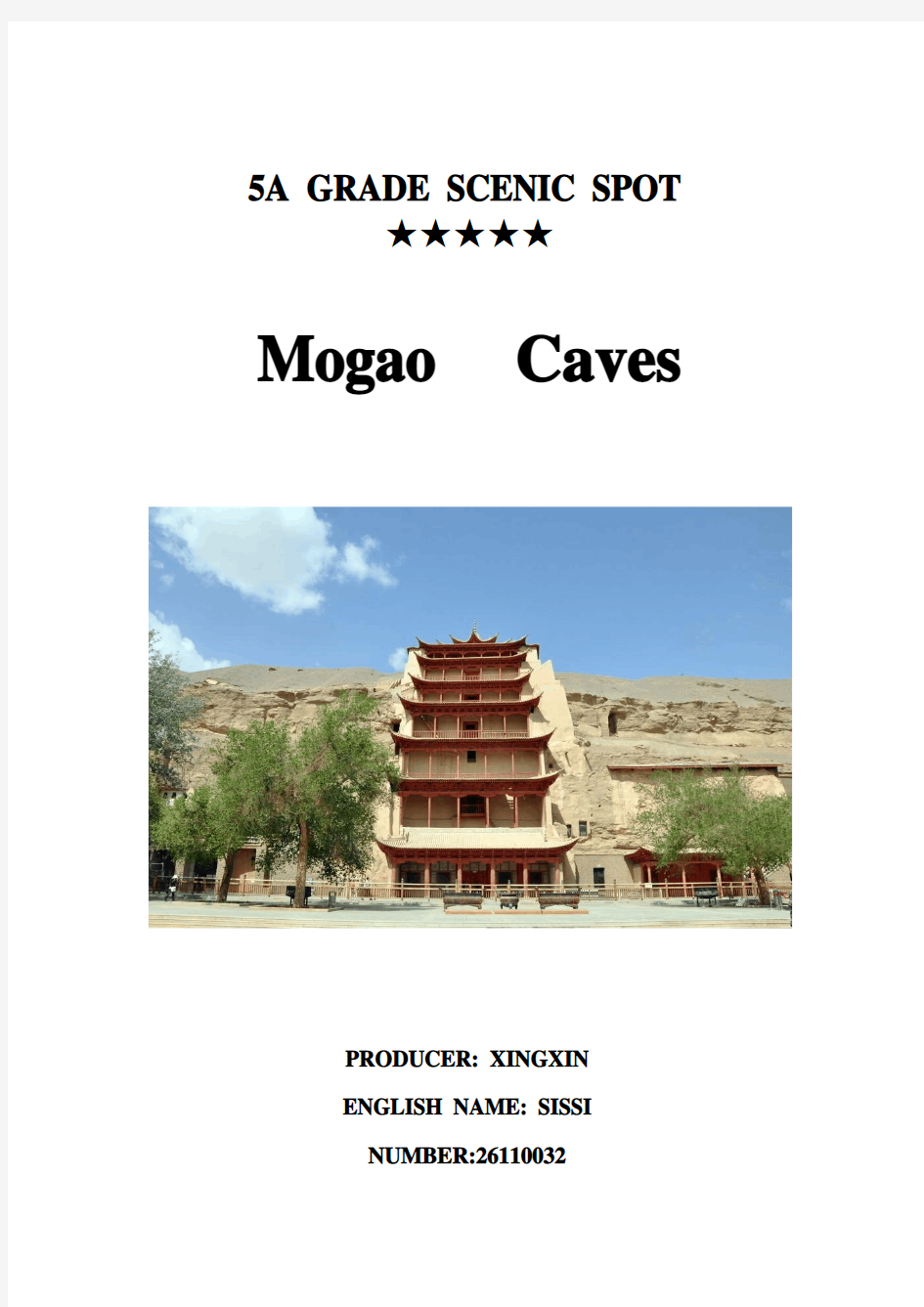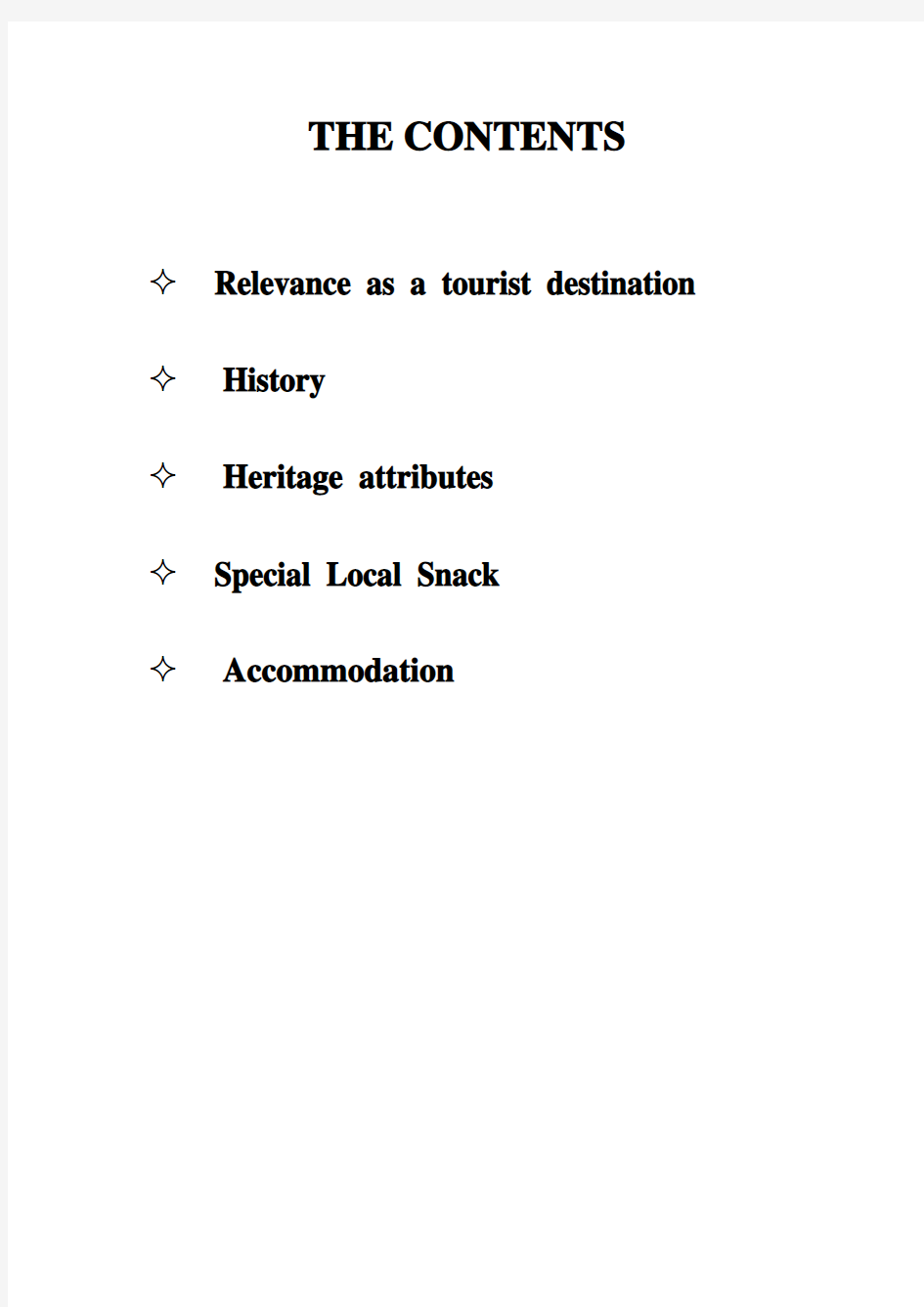莫高窟 Mogao Caves 中英文介绍


5A GRADE SCENIC SPOT
★★★★★Mogao Caves
PRODUCER: XINGXIN
ENGLISH NAME: SISSI
NUMBER:26110032
T H E C O N T E N T S
?Relevance as a tourist destination ? History
? Heritage attributes
?Special Local Snack
? Accommodation
Relevance as a tourist destination
The Mogao Caves or Mogao Grottoes , also known as the Caves of the Thousand Buddhas , form a system of 492 temples 25 km southeast of the center of Dun Huang, an oasis strategically located at a religious and cultural crossroads on the Silk Road, in Gan Su province, China.
The caves may also be known as the Dun Huang Caves, however, this term also include other Buddhist cave sites in the Dun Huang area, such as the Western Thousand Buddha Caves, and the Yu Lin Caves farther away. The caves contain some of the finest examples of Buddhist art spanning a period of 1,000 years.
Murals
The murals on the caves spanned a long period of history, from the 5th to the 14th century
The murals are largely of Buddhist theme, some however are of traditional mythical [‘miθik?l] themes(传统神话主题)and portraits (画像)of patrons (赞助人)
A distinct Dunhuang style (截然不同的的敦煌风格)however began to emerge(浮现)during Northern Wei Dynasty
Murals
The murals on the caves spanned a long period of history, from the 5th to the 14th century.
The murals are largely of Buddhist theme, some however are of traditional mythical themes and portraits of patron.
A distinct Dun Huang style however began to emerge during Northern Wei Dynasty.
History
The construction of the Mogao Caves near Dun Huang is generally taken to have begun sometime in the fourth century AD.
According to a book written during the reign of Tang Empress Wu, Fokan Ji by Li Junxiu , a Buddhist monk named Lè Zūn had a vision of a thousand Buddhas bathed in golden light at the site in 366 AD, inspiring him to build a cave here.
The story is also found in other sources, such as in inscriptions on a stele in cave 332, an earlier date of 353 AD however was given in another document .He was later joined by a second monk Faliang , and the site gradually grew, by the time of the Northern Liang a small community of monks had formed at the site.
Members of the ruling family of Northern Wei and Northern Zhou constructed many caves here, and it flourishe in the short-lived Sui Dynasty. By the Tang Dynasty, the number of caves had reached over a thousand.
During the Tang Dynasty, Dun Huang had became the main hub of commerce of the Silk Road and a major religious centre. A large number of the caves were constructed at Mogao during this era, including the two large statues of Buddha at the site, the largest one constructed in 695 following an edict a year earlier by Tang Empress Wu Zetian to build giant statues across the country. The site escaped the persecution of Buddhists ordered by Emperor Wuzong in 845 as it was then under Tibetan control. As a frontier town, Dun Huang had been occupied at various times by other non-Han Chinese people..
After the Tang Dynasty, the site went into a gradual decline, and construction of new caves ceased entirely after the Yuan Dynasty. Islam had conquered much of Central Asia, and the Silk Road declined in importance when trading via sea-routes began to dominate Chinese trade with the outside world.
During the Ming Dynasty, the Silk Road was finally officially abandoned, and Dun Huang slowly became depopulated and largely forgotten by the outside world. Most of the Mogao caves were abandoned, the site however was still a place of pilgrimage and used as a place of worship by local people at the beginning of the twentieth century when there was renewed interest in the site.
Heritage attributes
The caves were cut into the side of a cliff which is close to two kilometers long. At its height during the Tang Dynasty, there were more than a thousands caves, but over time, many of the caves were lost, including the earliest caves
735 caves currently exist in Mogao, the best-known ones are the 487 caves located in the southern section of the cliff which are places of pilgrimage and worship
248 caves have also been found to the north which were living quarters, meditation chambers and burial sites for the monks.
The caves at the southern section are decorated, while those at the northern section are mostly plain.
The caves are clustered together according to their era, with new caves from a new dynasty being constructed in different part of the cliff.
Special Local Snack
Niang Pi
SaoZi surface
Steal money rice
Donkey yellow surface
Buckwheat noodles
Accommodation
There are some not only cheap but comfortable hotels. Like Dun Huang hotel, MoGao hotel.
Dun Huang hotel
MoGao Hotel
THANKS FOR VIEWING
BYE !
